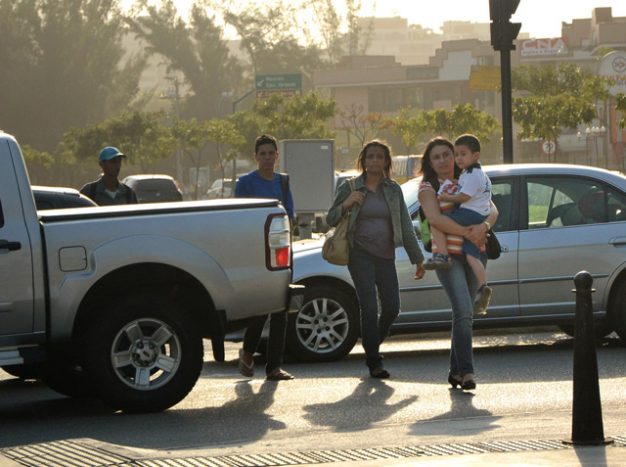
Why we need a summit on youth urban road safety
Our cities are rapidly expanding, and with them motorization is increasing at an unchecked pace. Unless the global community takes meaningful strides to address the impact of these trends on the most vulnerable in our society, we will be met by a catastrophic health emergency.
Every three minutes a child or young person dies as a result of road traffic injury. A quarter of a million children and adolescents die on the world’s roads every year. Road traffic injury is the fifth-leading cause of death for children aged 5 to 14 years old.
Beyond the headline figure, for every child who dies, another suffers an irrevocably life-changing disability. For each disability, there are several serious injuries.
In New York during the week of 17 July 2018, governments met for a High-Level Political Forum to assess progress on the United Nations’ Sustainable Development Goals, including SDG 11: to make cities “inclusive, safe, resilient and sustainable.”
High-Level Political Forums offer the opportunity to share successes and pave the way to scale up activity to really move towards the 2030 SDG targets. But this is only possible if countries commit to reporting progress made (or not made), so we can understand baseline activities and share in each other’s successes and challenges. That is why the FIA Foundation is calling for a summit for child and adolescent health to put young people at the top of the urban policy agenda.
An unequal burden
By 2030, the world is likely to have 43 megacities (those with more than 10 million inhabitants), mostly in developing countries. By 2050, two thirds of the world’s population are likely to be living in cities or other urban centers. In New York this week, countries have the option to submit what are called Voluntary National Reviews to share examples of proactive efforts to achieve the SDGs. It is clear from the reviews submitted that, despite the alarming trends, sustainable transport remains an abstract concept for many countries.
While 95 percent of reporting countries made reference to transport, just 38 percent described specific policy measures or case studies on sustainable transport. A functional and inclusive transport system is crucial to a successful, vibrant city – but how the infrastructure develops, and for whom, are every bit as important as the routes themselves.
Cities across the world have been guilty of designing streets to serve the car-driving minority, and marginalizing the poorest who use public transport, walk or bicycle. From New York to Nairobi, we can see where fast-flowing highways bisect residential areas, presenting a lethal obstacle course for those on foot, while throwing up toxic smog poisoning the lungs of everyone – outside and even inside cars.
The burden of vehicles in cities is carried most heavily by the poorest, but also the youngest.
The joint Overseas Development Institute and WRI Ross Center report, “Securing Safe Roads,” explores varied road safety challenges and their interaction with the political economy.
In New York City, for example, the child population is evenly spread at around 30 percent of the total. Yet children account for 43 percent of crash victims in lower-income East Harlem compared to 15 percent in the affluent Upper East Side. The World Health Organization says that “many of the children who are victims of this man-made calamity are poor. Attempts to address road safety for children are, therefore, inextricably linked to notions of social justice.”
In African cities, up to 90 percent of children walk to school, but less than 1 in 10 fast roads shared by pedestrians and vehicles (roads with speeds over 40 kilometers per hour) actually have any sidewalks. In urban areas, the dirtiest arterial roads are built away from expensive areas, but the same consideration is often not extended to the city’s poorest.
Urban air pollution is a significant contributor to childhood mortality rates, causing and exacerbating a wide range of serious respiratory and development issues, alongside long-term health conditions. In many cities, vehicles are responsible for a high proportion of air pollution, particularly near busy roads.
Urban traffic pollution particularly affects children because harmful emissions from cars and trucks are delivered directly at street level into their mouths and noses. It has the greatest impact on children under five, killing more than 127,000 each year. Three hundred million children currently live in areas where outdoor air pollution exceeds international guidelines by at least six times.
Walking the talk
Solutions to this great urban challenge are not, however, elusive. By drawing together transport, environment, public health and planning in a holistic approach, cities can begin to reorient around people, not vehicles. Positive examples of smart, intentional urban design and policy have shown that authorities can transform urban spaces into a walkable, livable, healthy environments and make significant inroads to address injuries, air pollution and climate change.
The Global Designing Cities Initiative, for example, works with 40 cities to demonstrate the impact and benefits of changing the hierarchy of street use and design to focus on pedestrians, cyclists and children. London has become the first city in the world to explicitly adopt a public health-first approach to urban planning that encourages active transport and reduces vehicle journeys to improve health outcomes for all.
A summit on child and adolescent health would ensure that the special vulnerability and importance of young people is not lost in these efforts and becomes a more integral part of the SDG reporting process.
As a global community, we have committed to a safe and sustainable transport systems for all by 2030 – including our most vulnerable. It is an ambitious target we should all be proud to work towards and the solutions are within our reach. But for now it remains talk, and our children need action.
This article was first published by The City Fix.




